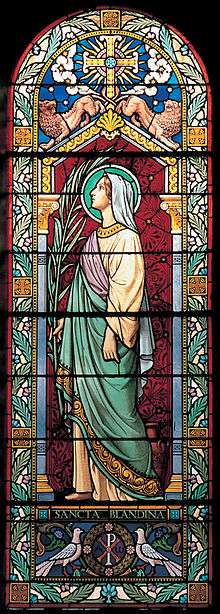Blandina
| Saint Blandina | |
|---|---|
|
Blandina half-roasted on a grill and then thrown to wild bulls | |
| Martyr | |
| Born |
c. 162 Lyon, France |
| Died |
177 Lyon, France |
| Venerated in | Roman Catholic Church, Eastern Orthodox, Western Rite Orthodoxy, Eastern Catholic Churches, Anglican Communion |
| Major shrine | Church of Saint-Leu, Amiens, France |
| Feast | June 2 |
| Attributes | A bull, depicted tied to a pillar with a lion and bear near her [1] |
| Patronage | those falsely accused of cannibalism, servant girls, torture victims |
Saint Blandina (French: Blandine, died 177 AD) was a Christian martyr during the reign of Emperor Marcus Aurelius.
Traditional history
She belongs to the band of martyrs of Lyon who, after some of their number had endured frightful tortures, suffered martyrdom in 177 in the reign of Marcus Aurelius. Almost all we know of Blandina comes from a letter sent from the Church of Lyon to the Churches of Asia Minor.[2] Eusebius gives significant space of her life and death in his book as he quotes from the aforementioned epistle to Asia Minor.[3] The fanaticism of the Roman populace in Lyon had been excited against the Christians so that the latter, when they ventured to show themselves publicly, were harassed and ill-treated.[4]
While the imperial legate was away, the chiliarch, a military commander, and the duumvir, a civil magistrate, threw a number of Christians, who confessed their faith, into prison. When the legate returned, the imprisoned believers were brought to trial. Among these Christians was Blandina, a slave, who had been taken into custody along with her master, also a Christian. Her companions greatly feared that on account of her bodily frailty she might not remain steadfast under torture. But although the legate caused her to be tortured in a horrible manner, so that even the executioners became exhausted "as they did not know what more they could do to her", still she remained faithful and repeated to every question "I am a Christian, and we commit no wrongdoing."[4]

Through fear of torture slaves had testified against their masters that the Christians when assembled committed cannibalism and incest, and the legate desired to wring confession of this misconduct from the Christian prisoners. In his report to the emperor the legate stated that those who held to their Christian belief were to be executed and those who denied their faith were to be released, and the legate received instructions from the Emperor Marcus Aurelius allowing the Roman citizens who persisted in the faith to be executed by beheading,[5] but those without citizenship were to be tortured. Blandina was therefore subjected to new tortures with a number of companions in the town's amphitheater (now known as the Amphitheatre of the Three Gauls) at the time of the public games.[4]
She was bound to a stake and wild beasts were set on her. According to legend, they did not, however, touch her. After enduring this for a number of days she was led into the arena to see the sufferings of her companions. Finally, as the last of the martyrs, she was scourged, placed on a red-hot grate, enclosed in a net and thrown before a wild steer who tossed her into the air with his horns, and at last killed with a dagger.[4]
Critical views
The tradition of the story is recounted by Eusebius in his Historia Ecclesiastica. If accurate, these events would suggest a shift from the official policy from a few decades earlier, which is reflected in the correspondence between Pliny the Younger and the Emperor Trajan. This previous policy declared Christianity "to be illegal, but that members of the faith were not to be sought, but killed if the charge was proven."
Nevertheless, there were some local (not general) anti-Christian persecutions in the early years of Christianity. It would seem from the "Epistle from the Gallican Churches" to the churches in Asia minor that such localized persecution had broken out in Lyon and Gaul (See again, Historia Ecclesiastica). While it would seem that Emperor Marcus Aurelius personally had nothing to do with the Lyon affair, he was criticized for not intervening.
Legacy

- Two communes in France are named after her. See Sainte-Blandine.[6]
- Her feast is celebrated June 2.[7]
See also
References
- ↑ Saint of the Day, June 2: Blandina SaintPatrickDC.org. Retrieved 2012-03-18.
- ↑ Butler, Alban. Lives of the Saints, Vol. VI, 1866
- ↑ Eusebius, Historia Ecclesiastica, Book 5.2.
- 1 2 3 4 Kirsch, Johann Peter. "St. Blandina." The Catholic Encyclopedia. Vol. 2. New York: Robert Appleton Company, 1907. 23 Apr. 2013
- ↑ Eusebius, Historia Ecclesiastica, Book 5.1.47
- ↑ Eusebius, Historia Ecclesiastica, Book 5.1.
- ↑ Saint of the Day, June 2: Blandina SaintPatrickDC.org. Retrieved 2013-08-05.
See also
- Christian martyrs
- Persecution in Lyon
- Acts of the Martyrs
- Age of Persecution
External links
| Wikimedia Commons has media related to Blandina. |
- (Italian) Santa Blandina
- Icons of St. Blandina, martyr All-Merciful Savior Orthodox Mission website
- Gnostic Gospels, Elaine Pagels, pp. 101–102
- Catholic Encyclopedia: St. Blandina
